Menu manager allows creating custom menus for your website and allows navigation through your website.
Step (1) − Click on Menus → Menu Manager in Joomla administrator, you will get the following screen −

You can see the menu and menu items point to logical page on the website.
Step (2) − To add a new menu to your website, go to Menus → Menu Manager → Add New Menu as shown in the following screen −
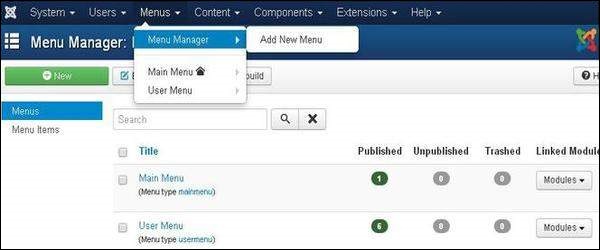
After clicking on Add New Menu, you will get the screen as shown below. Here you can create a new menu.

- Title − Title of the menu.
- Menu Type − Type of menu.
- Description − Brief description about the menu.
Step (3) − To create a new menu item, go to Menus → Name of the Menu→ Add New Menu Item as shown in the following screen −
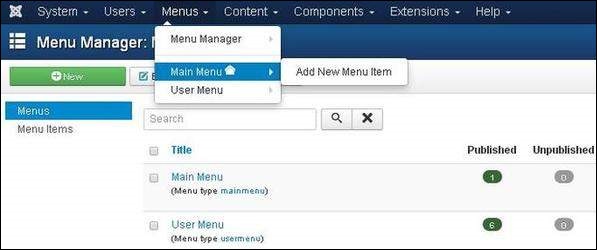
You can also add new menu item via User Menu. All the steps described below applies to menu item creation via this method.
When you open the page of a New Menu Item, you will get the following screen −
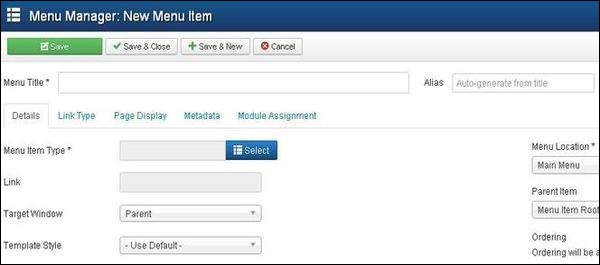
There are two main sections under New Menu Item −
- Menu Title − It displays the title of the menu item in the menu.
- Alias − It is used as SEF url. Joomla will automatically fill the value of the title. It will produce UTF-8 aliases; it does not allow spaces and underscores.
There are some tabs present while creating menu items as shown in the following screen −
Details
The Details tab in Add New Menu Item, is as shown below −
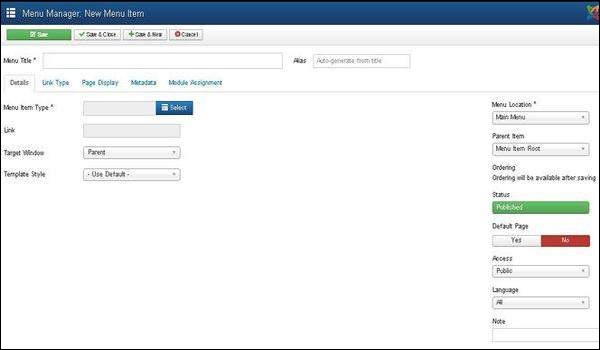
It contains the following options −
- Menu Item Type − It specifies the type of menu item such as articles, tags, web links, system links, contacts etc.
- Link − It determines the link in the menu.
- Target Window − It provides three options− Parent, New Window with Navigation and New without Navigation which targets the browser window when a menu item is clicked.
- Template Style − You can select a template style for your website by clicking dropdown menu which gives Beez3 - Default and protostar - Default styles or provides default templates for your website.
- Menu Location − It specifies which menu link will appear; either Main Menu or User Menu.
- Parent Item − This helps you select a parent item by selecting either Menu Item Root or Home.
- Status − It displays the status of the article. Status such as Published, Unpublished and Trashed.
- Default Page − It provides Yes or No options to set the menu item as default or home page of the site.
- Access − Only the selected option from this dropdown list such as Guest, Public, Super Users, Registered and Special can view the site.
- Language − It specifies the language of the site. It provides either ALLor English (UK) options.
- Note − It is used to enter the text information.
Link Type
The next tab is Link Type in Add New Menu Item, as show below −
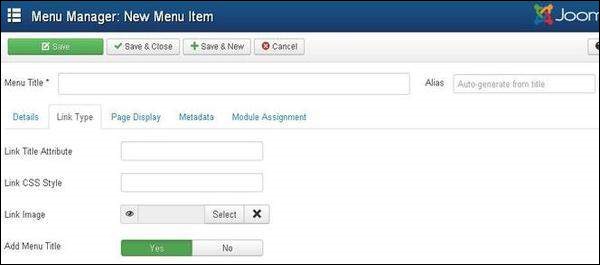
- Link Title Attribute − It specifies a description for the title attribute of the given hyperlink.
- Link CSS Style − It applies a custom CSS style to the hyperlink.
- Link Image − It uses an image to be used with hyperlink.
- Add Menu Title − It provides Yes or No options and adds the menu title next to the image. The default is Yes.
Page Display
The next tab Page Display in Add New Menu Item, is as shown below −
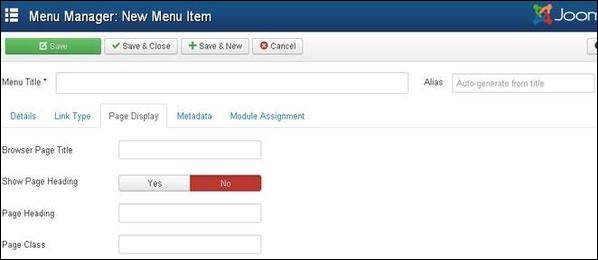
- Browser Page Title − It specifies the description of the browser page title.
- Show Page Heading − It provides Yes or No option which hides or shows the page title in the page heading.
- Page Heading − It specifies the text for the page heading.
- Page Class − It defines the optional CSS class to styling the elements in the page.
Metadata
The next tab Metadata in Add New Menu Item, is as shown below −
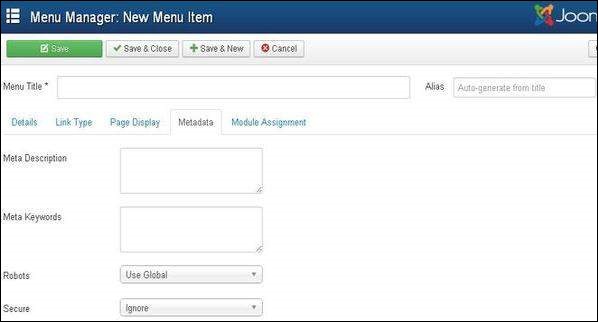
It contains following options as described below −
- Meta Description − It is used as an optional paragraph which includes a description of the page and is displayed in the results of the search engines.
- Meta Keywords − These are the optional keywords to be used in the html page.
- Robots − It specifies robot instructions such as use Global, Index, Follow, No Index,No Index, No follow.
- Secure − It defines whether link must use SSL or Secure Site URL. It provides three options such as Off, On and Ignore.
No comments:
Post a Comment